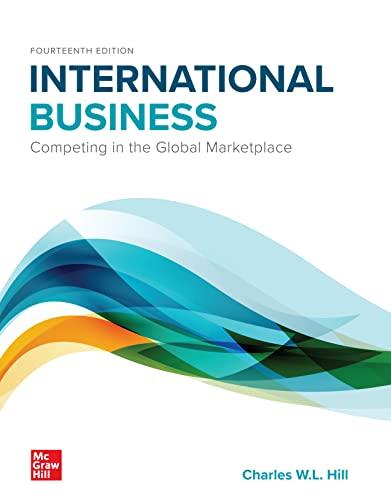President Donald Trump spent much of his time in office erecting barriers to trade with other nations,
Question:
President Donald Trump spent much of his time in office erecting barriers to trade with other nations, but in early 2020 his administration signaled that it wanted to do something different: negotiate a free trade deal between the United States and the East African nation of Kenya.
The Trump administration saw a free trade deal with Kenya in geopolitical terms. The administration believed it was an important step toward countering China’s growing influence in Africa. It also believed that a successful trade deal could act as a model for other deals between the United States and African nations. In July 2020, the two countries embarked upon formal negotiations to finalize a deal. If successfully concluded, this would be the 15th bilateral free trade agreement that the United States has with other nations.
Robert Lighthizer, the U.S. Trade Representative, noted that Africa is only a few years away from being the world’s population center and that “if we don’t find a way to move them right, then China and the others are going to move them in the wrong direction.” China has already lent vast sums of money to African nations, including Kenya, and built roads and bridges around the continent as part of its Belt and Road Initiative, which is designed to put China at the hub of the twenty-first-century global trading economy. These projects include a 300-mile, $4 billion railway in Kenya that has linked the capital city of Nairobi, located in the country’s highlands, with the port city of Mombasa. But some of these projects, including those in Kenya, have left African governments saddled with billions of dollars of debt to China. They have also sparked distrust and resentment toward China, which has often used Chinese companies and managers to complete the projects, leading to charges of neocolonialism. It hasn’t helped China’s case that some of these managers have been caught on phone videos making racist comments to their African workers.
Lighthizer saw the resentment against China as an opportunity for the United States to step in and begin discussions with Kenya. The choice of Kenya is not surprising.
Kenya has emerged as one of the economic growth stories of sub-Saharan Africa. Real gross domestic product grew at 4.9 percent in 2018 and 5.6 percent in 2019. Growth for 2020 was expected to be in the 6 percent range. The country is East Africa’s economic, financial, and transportation hub, and it has a growing reputation for entrepreneurial activity. Moreover, this nation of 53 million people has a young, tech-savvy, and vibrant population (more than 40 percent of Kenyans are under the age of 16). It also has one of the better educational systems in the region, which is a positive for future economic growth. That being said, trade between the United States and Kenya stands at just $1 billion a year, barely putting Kenya in the top 100 of U.S. trading partners, so any trade deal with Kenya is unlikely to have a noticeable impact on the U.S. economy.
For its part, Kenya has signaled it would welcome such a deal. America was the country’s third-biggest trading partner in 2019, importing $667 million worth of clothing, fruit, nuts, and coffee. Another consideration here is that the African Growth and Opportunity Act (AGOA), which gives 39 sub-Saharan African countries duty-free access to the American market, is due to expire in 2025 (the act was passed by the U.S. Congress and signed into law in May 2000). The affected countries are anxious to have something in place when that happens, even though in recent years, despite the AGOA, more sub-Saharan exports have headed to the EU, China, and India than to America. Rather than extend the AGOA, Lighthizer has called for a more permanent arrangement.
The proposed bilateral trade deal between Kenya and the United States can be seen as part of this strategy.
There is, however, a catch here. For one thing, much of the bargaining power is on the American side. The U.S.
economy is 200 times bigger than Kenya’s, and some worry that American negotiators will use this disparity to get a deal that strongly favors America, as opposed to a true free trade deal. Another problem is that this proposed bilateral deal might run counter to a multilateral agreement among 54 African nations that Kenya has already signed and that went into effect in 2020. Known as the African Continental Free Trade Area (AfCFTA), this multilateral deal is designed to create a continentwide free trade area. By signing a deal that is separate from AfCFTA, some observers worry that a free trade area between the United States and Kenya could undermine the AfCFTA. Kenya, however, is unlikely to be deterred by such concerns.
Case Discussion Questions 1. What is China’s interest in investing heavily in infrastructure projects in countries such as Kenya? What is China trying to achieve with its Belt and Road Initiative? Should American policy makers be concerned about China’s actions and intentions here?
2. In purely economic terms, who would benefit from a free trade deal between the United States and Kenya? Who might lose? Would you expect the net effect to be positive or negative?
3. Would a free trade deal have geopolitical implications for the United States? What about for Kenya?
Step by Step Answer:

International Business Competing In The Global Marketplace
ISBN: 9781260387544
14th Edition
Authors: Charles Hill





